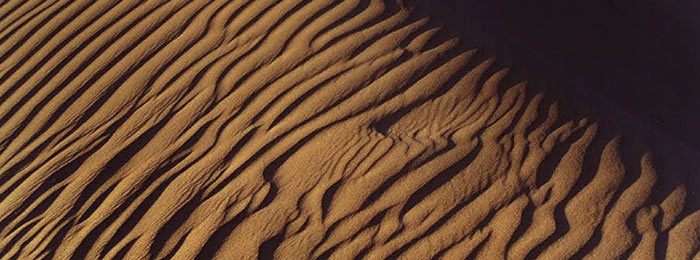
Ripples: Finding Order amid Chaos: Part 1
 Most of us have been to the beach and noticed a peculiar pattern in the sand or mud. This pattern is usually composed of a series of ridges and depressions, which altogether we call "ripples." Sometimes the ridges are spaced very far apart, other times they are close together (this is known as the "frequency" of ripples). Sometimes the tops of each ridge rise up very high, and other times they remain low-lying (this is known as the "amplitude" of ripples). And ripples never form in perfect lines; they often cut each other off, are irregular in shape, and seem to disappear or fade away with little to no reason.
Most of us have been to the beach and noticed a peculiar pattern in the sand or mud. This pattern is usually composed of a series of ridges and depressions, which altogether we call "ripples." Sometimes the ridges are spaced very far apart, other times they are close together (this is known as the "frequency" of ripples). Sometimes the tops of each ridge rise up very high, and other times they remain low-lying (this is known as the "amplitude" of ripples). And ripples never form in perfect lines; they often cut each other off, are irregular in shape, and seem to disappear or fade away with little to no reason.
Ripples don't just form in watery environments. If you've ever been to the dunes, this is no news to you. Our dunes are riddled with ripples! So what exactly are ripples? How do they take shape, and why are they so variant in frequency and amplitude?
While recognized as a widespread phenomenon throughout the globe, ripples are a bit of a conundrum for scientists. The basic reasons that ripples form are well understood, but the shear number of variables that go into making ripples can make anyone's head spin.
Here are the basics:
1. A fluid (water or air) gathers enough energy to move solid particles of differing size and shape over a irregular surface.
2. The lighter particles, or grains, are more easily moved while the larger and heavier grains stick around.
3. The heavier particles then tend to gather and form a "ridge." The lighter materials are swept away by the wind or water and a depression, or "trough" is formed.
From that point on, you have to consider the angle at which the wind is hitting the sand, the angle of the slope of the sand in each ripple, the strength of the wind or water current, the density of the fluid moving the grains (wind and water), the differences in grain size, shape, and density... the list goes on and on.
While demystifying the minute details that go into making ripples may seem like a task more suited to a super computer, humans remain superior in our ability to recognize patterns. This has made ripples an intense subject of study for artists.

This charcoal sketch of a dunes landscape was done by Elwood Decker, a Dunite who resided in the dunes during the mid 1940's.
Show us your best photos of ripples and ridges! If you have photos of ripples that you'd like to share with us, please send them our way!
Please stay tuned for our next installment of Ripples: Finding Order amid Choas!
Upcoming Events
Nipomo, 93444 United States
Newsletter
Our newsletter keeps you up to date with the latest information about our exhibits, upcoming events, and programs.



